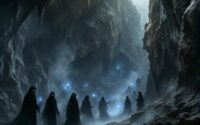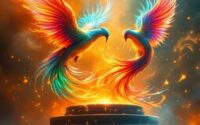The Underworld Journeys in World Mythology
Throughout human history, cultures worldwide have crafted elaborate tales of heroes descending into the domain of the dead. These underworld journeys aren’t mere adventure stories—they’re profound explorations of mortality, redemption, and forbidden knowledge. From Mesopotamian epics to Greek tragedies, these narratives share striking similarities that transcend geographical boundaries. What compels civilizations separated by thousands of miles and years to envision such parallel journeys into death’s realm?
Introduction

When ancient peoples gazed into dark caves, crossed treacherous waters, or watched the sun disappear beyond the horizon, they couldn’t help but wonder what lay beyond the veil of death. This universal curiosity sparked countless myths about heroes who’d venture into underworld domains and return to tell their tales. These narratives aren’t mere entertainment; they’re humanity’s attempt to comprehend mortality, justice, and rebirth.
From Mesopotamia’s Inanna to Greece’s Orpheus, from Egypt’s Ra to Japan’s Izanagi, cultures worldwide crafted stories of descent and ascension. Each journey reflects its society’s values, fears, and hopes for what awaits after death. Whether seeking lost loves, divine wisdom, or stolen treasures, these mythic travelers mapped invisible territories that continue to shape how modern humans understand life’s greatest mystery.
Ancient Mesopotamian Gilgamesh Epic
The oldest recorded underworld journey emerges from ancient Mesopotamia’s clay tablets, where the Epic of Gilgamesh chronicles humanity’s first literary hero confronting death’s reality. Gilgamesh doesn’t personally descend to the underworld, but he encounters it through two pivotal experiences. First, his companion Enkidu dreams of the netherworld before dying, describing its darkness where humans exist as bird-like shadows eating dust. Later, Gilgamesh summons Enkidu’s spirit through a hole in the earth, learning the grim fate awaiting all mortals.
The epic’s underworld represents humanity’s earliest written anxieties about mortality. Unlike later mythologies offering redemption or rebirth, Mesopotamia’s land of the dead promises only eternal gloom. This bleak vision drives Gilgamesh’s desperate quest for immortality, ultimately teaching him that humans can’t escape death but must find meaning within life’s boundaries.
Notable Cases or Sightings

Several mythological heroes have ventured into death’s territory and returned to tell their tales, establishing a pattern that’s shaped literature for millennia. Orpheus descended to retrieve Eurydice from Hades, armed only with his lyre’s enchanting music. He’d nearly succeeded when a backward glance condemned his beloved to eternal darkness. Odysseus sailed to the underworld’s edge, consulting the prophet Tiresias about his journey home while witnessing the fates of fallen warriors. Aeneas navigated the underworld with the Sibyl’s guidance, encountering his father Anchises who revealed Rome’s destined glory. Inanna’s descent into her sister’s dark domain resulted in her death and resurrection, establishing seasonal cycles. These journeys weren’t mere adventures—they’ve become archetypal narratives exploring mortality, love’s limits, and humanity’s relationship with death itself.
Common Theories or Explanations
Scholars have long debated why underworld journeys appear across disconnected cultures, proposing psychological and sociological frameworks that might explain their universal appeal. Carl Jung’s theory of collective unconscious suggests these myths tap into shared human archetypes about death and rebirth. The descent represents confronting one’s shadow self, while the return symbolizes psychological integration and transformation.
Joseph Campbell’s monomyth structure positions the underworld journey as humanity’s ultimate trial—where heroes face mortality itself. Anthropologists argue these stories serve practical functions: they help societies process grief, establish moral codes, and provide comfort about the afterlife. Some theorists link the myths to shamanic practices, where ritual specialists “journey” to other dimensions through trance states. These explanations aren’t mutually exclusive; they collectively illuminate why cultures worldwide independently developed such strikingly similar narratives.
Frequently Asked Questions
How Do Modern Religions Interpret Ancient Underworld Journey Myths?
Modern religions often interpret ancient underworld journey myths as spiritual metaphors for transformation, death and resurrection, or the soul’s trials. They’ve adapted these narratives to represent moral teachings, afterlife beliefs, and humanity’s spiritual evolution.
What Psychological Meanings Do Scholars Attribute to Underworld Descent Narratives?
Scholars interpret underworld descents as psychological metaphors for confronting one’s shadow self, processing trauma, and achieving individuation. They’ve linked these narratives to depression, spiritual transformation, and the hero’s journey through life’s darkest moments.
Are There Common Symbols or Motifs Across Different Cultures’ Underworld Stories?
Yes, scholars identify recurring motifs: rivers marking boundaries, guardian figures at entrances, tests or trials, magical objects needed for passage, guides who assist heroes, and transformative returns where protagonists gain wisdom or power.
How Have Underworld Journey Myths Influenced Contemporary Literature and Media?
Underworld journey myths’ve profoundly shaped contemporary storytelling. Writers adapt these ancient narratives into modern heroes’ psychological transformations. Films, novels, and games frequently feature protagonists who descend into darkness, confront death, and return transformed with wisdom.
What Ritual Practices Were Historically Associated With Underworld Journey Beliefs?
Ancient cultures performed death simulations, vision quests, and mystery initiations that reenacted underworld descents. Shamans used drumming and psychoactive plants to journey spiritually. Greeks practiced Eleusinian Mysteries while Egyptians conducted elaborate mummification rituals mimicking Osiris’s resurrection.


